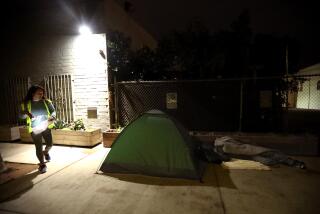Who Are the Displaced?
According to a survey by Shelter Partnership, a downtown Los Angeles-based program, the fastest-growing segment of the county’s suburban homeless--nearly one-third--are families with children. Another one-third are veterans. From 10% to 25% are working but cannot afford housing. About one-quarter are mentally ill, nearly 15% are alcoholics, and 16% are drug abusers. Some of the homeless are included in more than one category.
In 1986, a United Way study of Los Angeles County concluded that 35,000 people are homeless. The study estimated that roughly 7% of those--or 2,450 men, women and children--can be found in the South Bay-Long Beach area.
Even that study, however, relied on statistics supplied by shelters, food pantries and soup kitchens. There are comparatively few such facilities in the South Bay, and officials at those that do exist say there are many homeless people who are too frightened or too mentally ill to seek their help.
The reasons for homelessness vary, but much of it can be attributed to growing numbers of families dropping below the federal poverty line. In 1980, 13.4% of the county’s population was living in poverty, defined as an annual income of less than $8,850 for a family of three. That percentage now has risen to about 16%.
In addition, state and federal policies aimed at moving the mentally ill out of institutions--without providing adequate outpatient services--have helped increase the numbers of homeless mentally ill on the streets, social workers say.
They cite a telling statistic: 40,000 mental patients were housed in California state hospitals in 1969. That number had dropped to 5,000 patients in 1985.
More to Read
Sign up for Essential California
The most important California stories and recommendations in your inbox every morning.
You may occasionally receive promotional content from the Los Angeles Times.










